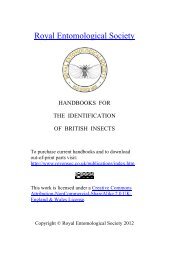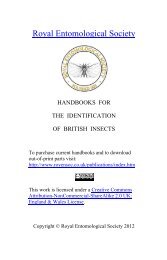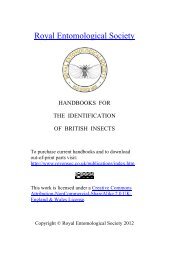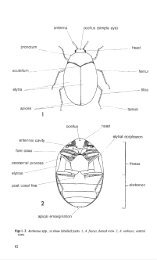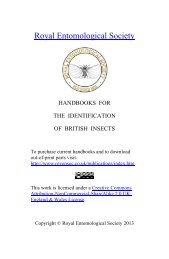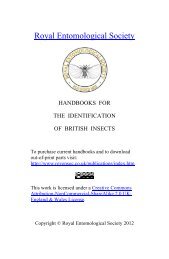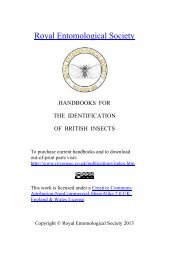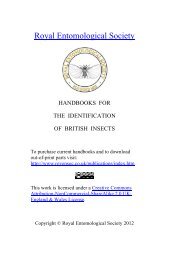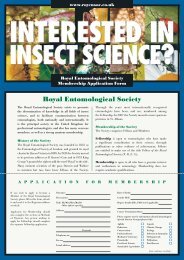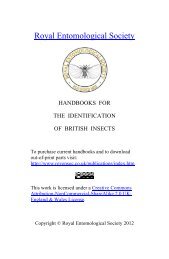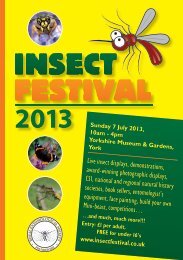Vol 10 Part 14. An introduction to the immature stages of British Flies ...
Vol 10 Part 14. An introduction to the immature stages of British Flies ...
Vol 10 Part 14. An introduction to the immature stages of British Flies ...
Create successful ePaper yourself
Turn your PDF publications into a flip-book with our unique Google optimized e-Paper software.
Aenigmatias on ants), Syrphidae (Microdon, ants; <strong>Vol</strong>ucella, wasps), Sphaeroceridae,<br />
Milichiidae (ants), Braulidae (honey-bees), Sarcophagidae (Mil<strong>to</strong>gramminae, wasps<br />
and bees), Fanniidae, Muscidae.<br />
Birds' nests (useful references: Hicks, 1959, 1963a, 1971; Woodr<strong>of</strong>fe, 1953): Sca<strong>to</strong>psidae,<br />
Chironomidae (Bryophaenocladius nitidico/lis (Goetghebuer)), Scenopinidae,<br />
Phoridae, Chyromyidae, Piophilidae (Neottiophilinae), Carnidae, Heleomyzidae,<br />
Trixoscelidae, Sphaeroceridae, Fanniidae, Muscidae (some Helina, Hydrotaea, Muscina,<br />
Ophyra), <strong>An</strong>thomyiidae (<strong>An</strong>thomyia), Sarcophagidae, Calliphoridae (especially<br />
Pro<strong>to</strong>ca/liphora, Calliphora), Hippoboscidae.<br />
Mammal burrows and nests (useful references: Hackman, 1967; Hutson, in<br />
Stubbs & Chandler, 1978): Heleomyzidae, Sphaeroceridae, Phoridae, Camillidae,<br />
Sciaridae.<br />
Fuller lists <strong>of</strong> rea rings <strong>of</strong>Diptera from nests are given in <strong>the</strong> references cited. Careful<br />
work is still needed on <strong>the</strong> ecology <strong>of</strong> nest-frequenting Diptera. E. B. Basden's extensive<br />
collection <strong>of</strong>Diptera from nests is available for study in <strong>the</strong> Royal Museum <strong>of</strong> Scotland<br />
(see Ro<strong>the</strong>ray, 1989 for summary).<br />
Plant feeders. The larval <strong>stages</strong> <strong>of</strong> many Diptera are described in <strong>the</strong> literature as<br />
living in and feeding on 'decaying vegetation'-a category not specifically included in<br />
this Handbook, except for dead wood. However, many terrestrial (some aquatic larvae<br />
feed on algae and mosses) species feed on <strong>the</strong> living tissues <strong>of</strong> plants in specific ways as<br />
listed below. Records marked with a need fur<strong>the</strong>r investigation or confirmation.<br />
Larvae <strong>of</strong> agricultural importance are treated more fully in <strong>the</strong> section so titled.<br />
Surface leaf feeders: Tipulidae (Cylindro<strong>to</strong>minae, mosses), Myce<strong>to</strong>philidae (Boletina,<br />
liverworts; Gnoriste, mosses; Docosia, lichens), Rhagionidae (Ptiolina on mosses).<br />
Leaf-miners: Cecidomyiidae (some Lestremiinae, liverworts; higher plants),<br />
Chironomidae, Sciaridae (Phy<strong>to</strong>sciara on Ranunculus), Rhagionidae (Spania nigra<br />
Meigen, liverworts), Dolichopodidae (Thrypticus, in stems), Syrphidae (some Cheilosia),<br />
Agromyzidae, Tephritidae (some), <strong>An</strong>thomyzidae (<strong>An</strong>agnota, Paranthomyza),<br />
Lauxaniidae, Psilidae, Drosophilidae (Scap<strong>to</strong>myza), Ephydridae, Scathophagidae,<br />
<strong>An</strong>thomyiidae (especially Pegomya). Mines caused by Diptera (unlike o<strong>the</strong>r orders)<br />
show primary and secondary feeding tracks causing a characteristic herring-bone pattern<br />
and linear mines have <strong>the</strong> frass lying alternately on <strong>the</strong> two sides (Hering, 1951);<br />
this is because mining Diptera larvae feed on <strong>the</strong>ir sides, facing first one direction, <strong>the</strong>n<br />
<strong>the</strong> o<strong>the</strong>r.<br />
Gall-formers: Cecidomyiidae, Tephritidae, Lauxaniidae (Calliopum, clover and<br />
Viola), Chloropidae (Lipara, reeds; Chlorops pumilionis Bjerkander, barley).<br />
Many o<strong>the</strong>r Diptera larvae feed in stems, roots, flowers, seeds and fruits, some <strong>of</strong><br />
which are <strong>of</strong> economic importance (see section on Agricultural Importance). Uffen &<br />
Chandler (in Stubbs & Chandler, 1978) list <strong>the</strong> Diptera associated with <strong>the</strong> higher<br />
plants. Teskey (1976) gives an account <strong>of</strong> Diptera larvae associated with trees (in<br />
North America), including those developing in sap exudates. Kitching (1971) deals<br />
specifically with <strong>the</strong> insect fauna <strong>of</strong> tree rot-holes (see index also).<br />
Fungi. The larval Diptera found in fungi have been <strong>the</strong> subject <strong>of</strong> some detailed<br />
studies (Bux<strong>to</strong>n, 1960; Smith, 1956; Trifourkis, 1977). Chandler (in Stubbs &<br />
Chandler, 1978) lists in detail <strong>the</strong> known fungus associations <strong>of</strong> <strong>British</strong> Diptera, which<br />
involve larvae <strong>of</strong> <strong>the</strong> following families: Trichoceridae, Tipulidae, Psychodidae, Cera<strong>to</strong>pogonidae,<br />
Chironomidae, <strong>An</strong>isopodidae, Myce<strong>to</strong>philidae, Sciaridae, Sca<strong>to</strong>psidae,<br />
Cecidomyiidae, Scenopinidae, Empididae (as preda<strong>to</strong>rs), Dolichopodidae, Phoridae,<br />
Platypezidae, Syrphidae (some Cheilosia), Platys<strong>to</strong>matidae, Dryomyzidae, Heleomyzidae,<br />
Sepsidae, Lauxaniidae, Sphaeroceridae, Lonchaeidae, Piophilidae, Odiniidae,<br />
Asteiidae, Drosophilidae, Chloropidae, Tachinidae (as parasites <strong>of</strong> Lepidoptera<br />
(Tineidae)), <strong>An</strong>thomyiidae, Fanniidae, Muscidae (as preda<strong>to</strong>rs).<br />
<strong>10</strong>




